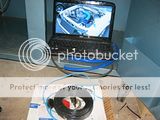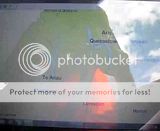Road Warrior Dyno System details. As it might evoke post apocalyptic state of decay, it is a road workers dynamometer, but with a much greater level or real world repeatablility. Its primary advantage is that it suits a build own operate transfer environment where test equipement is always a whole pacakage of gearbox, engine, carb, exhast, diff ratio and vehicle with a set frontal area and size.
I'm currently putting the finishing touches on the Road Warrior Dyno System. It's basically :-
1. an advanced cruise control defined road load device which allows my engine combinations to be baselined against a set load, a little like the Federal Motor Vehicle emissions test cycle.
2. It's a spin off from my road roughness calibration process with my 16 bit data loggers, and uses two computers. It works in with any 32 bit EEC5/OBD2 computer and as such it has acess to 60 sensors, but uses a 16 bit Cambell Scientific Data logger to interegate the baseline speeds against a Road Asset Maintenance Managment (RAMM) Log which gives a height to distance plot.
3. Each journey is taken at a time to remove the influence of other vehicles, and produces a brake specific fuel consumption value from defined road load. I've got all that data from NZS 260 series contor maps and RAMM data.
4. It continues along with the BOOT philosphy of Building, Owning, Operating, then Transferring engine and transmission combinations, without the overhead of dedicated shop dyno equipment. This means I can run the set-up as a cottage industry, which can be transferred anywhere in the world, but using local, proprietry parts.
All this can be replicated by a counterweighted power absorption dyno, so a dyno run could be made which is the same as, say, a Dunedin to Te Anau return journey. Since it covers considerable height change and extreme temperature variances, it's like a hyperbarmetric dynamometer
It basically electronically logs a pace vehicle or baseline vehicle, (in this case, my 205 hp 1998 Ford Explorer). The candiate engine, weather it be a cross flow, log, 2V or SOHC/DOHC in line six, is then put into either my 4 x4 Explorer or 2 wheel drive Mustang, and then driven over a 2500 mile test loop as part of the validation process. The loops include the Southland Te Anau in Fijorland National Park, the Otago and lower Canterbury road network, and has access to the Teretonga and Levels raceway (Invercargill and Timaru in the South island). Distance in these areas varies anwherer from above sea levels from 5 to 3100 feet. Grades go up to 12% for long grades, and steeper for short distances.
In addition, a 1/4 mile drag strip based on a closed down local aerodrome is run after the engine is run in. Then a cylinder check for surface texture and leakdown is made before bundling the engine off into a box to the new owner.
From this, fuel consumption, power, torque and real world drive characteristics can be determined before each engine combination is sold.
I'm currently putting the finishing touches on the Road Warrior Dyno System. It's basically :-
1. an advanced cruise control defined road load device which allows my engine combinations to be baselined against a set load, a little like the Federal Motor Vehicle emissions test cycle.
2. It's a spin off from my road roughness calibration process with my 16 bit data loggers, and uses two computers. It works in with any 32 bit EEC5/OBD2 computer and as such it has acess to 60 sensors, but uses a 16 bit Cambell Scientific Data logger to interegate the baseline speeds against a Road Asset Maintenance Managment (RAMM) Log which gives a height to distance plot.
3. Each journey is taken at a time to remove the influence of other vehicles, and produces a brake specific fuel consumption value from defined road load. I've got all that data from NZS 260 series contor maps and RAMM data.
4. It continues along with the BOOT philosphy of Building, Owning, Operating, then Transferring engine and transmission combinations, without the overhead of dedicated shop dyno equipment. This means I can run the set-up as a cottage industry, which can be transferred anywhere in the world, but using local, proprietry parts.
All this can be replicated by a counterweighted power absorption dyno, so a dyno run could be made which is the same as, say, a Dunedin to Te Anau return journey. Since it covers considerable height change and extreme temperature variances, it's like a hyperbarmetric dynamometer
It basically electronically logs a pace vehicle or baseline vehicle, (in this case, my 205 hp 1998 Ford Explorer). The candiate engine, weather it be a cross flow, log, 2V or SOHC/DOHC in line six, is then put into either my 4 x4 Explorer or 2 wheel drive Mustang, and then driven over a 2500 mile test loop as part of the validation process. The loops include the Southland Te Anau in Fijorland National Park, the Otago and lower Canterbury road network, and has access to the Teretonga and Levels raceway (Invercargill and Timaru in the South island). Distance in these areas varies anwherer from above sea levels from 5 to 3100 feet. Grades go up to 12% for long grades, and steeper for short distances.
In addition, a 1/4 mile drag strip based on a closed down local aerodrome is run after the engine is run in. Then a cylinder check for surface texture and leakdown is made before bundling the engine off into a box to the new owner.
From this, fuel consumption, power, torque and real world drive characteristics can be determined before each engine combination is sold.
















